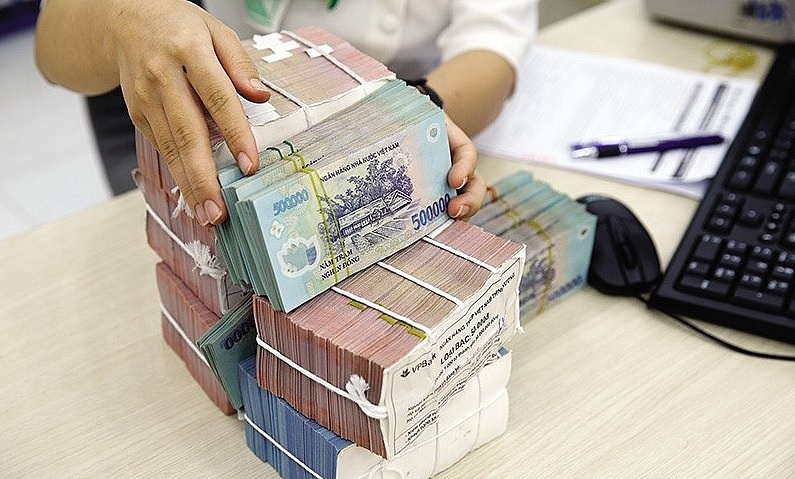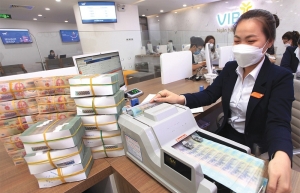OMO and T-bill rate cuts to stimulate manufacturing
The central bank (SBV) last week took the significant step of reducing its open market operation (OMO) interest rates for the first time since the end of 2023, while lowering the lending rate by 0.25 basis points to 4.25 per cent per annum, while the scale of OMO lending increased more than twofold compared to the previous session.
 |
| OMO and T-bill rate cuts to stimulate manufacturing, Photo: tinnhanhchungkhoan.vn |
“The reduction in OMO rates alleviates short-term lending pressure, thereby easing the financial burden on commercial banks,” said Nguyen The Minh, head of Research and Development for Retail Clients at Yuanta Securities Vietnam.
“This facilitates the maintenance of lower lending rates, which in turn promotes the expansion of credit activities, particularly loans to manufacturing enterprises. Thanks to this policy, the SBV does not need to adjust interest rates upwards at present, but can maintain rate stability to support the economy.”
Additionally, the SBV has issued $135.42 million in 14-day treasury bills (T-bills), with the accepted bid rate decreasing to 4.25 per cent per annum from 4.5 per cent per annum in the early August session.
As T-bills rates decrease, banks can lower their lending rates to maintain profit margins and remain competitive in the lending market. This also contributes to supporting businesses and stimulating economic activities in the latter half of the year across Vietnam.
The simultaneous reduction of these two types of interest rates has substantial implications for foreign enterprises and importers following a period of exchange rate stress, added Minh.
“Recent credit conditions have been significantly influenced by debt resolution efforts, shaping the manner in which credit is provided or managed going forward,” he said.
“The SBV’s reduction of both T-bills and OMO rates not only helps banks reduce input pressure but also stabilises and improves net interest margins, while creating even stronger conditions for sustainable credit expansion without increasing non-performing loans.”
The timing for using these regulatory tools is advantageous as the exchange rate has continued to slightly decrease to around VND24,260/USD during the trading session on August 15, following a period of significant pressure since April, which led the SBV to implement various measures in order to narrow the interbank rate spread.
“Given the high likelihood that exchange rates and inflation will moderate towards the end of the year, the SBV will have more room to ease and maintain interest rates at reasonable levels to support domestic enterprises’ continued recovery into the end of the year,” stated Shinhan Securities Vietnam in its August macroeconomic report.
Financial institutions have implemented various measures to assist businesses and individuals in accessing credit at very low interest rates.
However, some manufacturing and domestic service sectors still face considerable difficulties, with many production and business plans lacking feasibility and non-performing loans potentially rising.
Dao Minh Tu, Deputy Governor of the SBV, said, “We cannot fix the exchange rate in the context of global economic fluctuations, so the balanced solution is to harmonise exports and imports, and to comprehensively address exchange rate policies alongside interest rate policies, ensuring inflation control and the balance of foreign exchange supply and demand.”
According to the SBV’s recently released mid-year report, average lending rates have decreased to 8.3 per cent per annum in the first half of the year, a drop of 0.96 basis points compared to the end of last year.
“The economic recovery in the latter half of the year will be more pronounced than in the first half, so capital absorption is expected to improve. New customers will have increased demand for credit to expand production and business activities,” explained Pham Duy Hieu, the general director of ABBank.
The SBV’s simultaneous reduction of interest rates on both T-bills and OMO is expected to stimulate business activity among manufacturing enterprises and the overall economy in the latter half of the year, Hieu said.
 | Policies could pump in more credit in H2 Economic growth outlook for the last six months of the year and the influence of international geo-political developments prompt Vietnam to continue maintaining its monetary policy in a flexible manner to reduce lending rates for businesses. |
What the stars mean:
★ Poor ★ ★ Promising ★★★ Good ★★★★ Very good ★★★★★ Exceptional
Related Contents
Latest News
More News
- Tax sector wraps up 2025 and sets priorities for next year (December 25, 2025 | 14:00)
- A tipping point for digital and hybrid wealth management in Vietnam (December 23, 2025 | 13:33)
- $250 million deal targets women-owned SMEs, sustainable agriculture (December 22, 2025 | 17:40)
- Stock market posts resilient 2025 performance (December 19, 2025 | 18:17)
- Citi Vietnam receives 2025 AmCham CSR recognition (December 19, 2025 | 16:35)
- As global green supply chain reshapes, will Vietnam be left behind? (December 19, 2025 | 08:00)
- Banks gear up for massive capital increases (December 18, 2025 | 17:04)
- Securing capital and efficiency for Vietnam’s 2026-2030 growth ambitions (December 17, 2025 | 10:00)
- Energy sector in need of blended finance mechanisms (December 17, 2025 | 09:00)
- Vietnam still has room to mobilise capital for sustainable growth (December 17, 2025 | 08:57)

 Tag:
Tag:





















 Mobile Version
Mobile Version